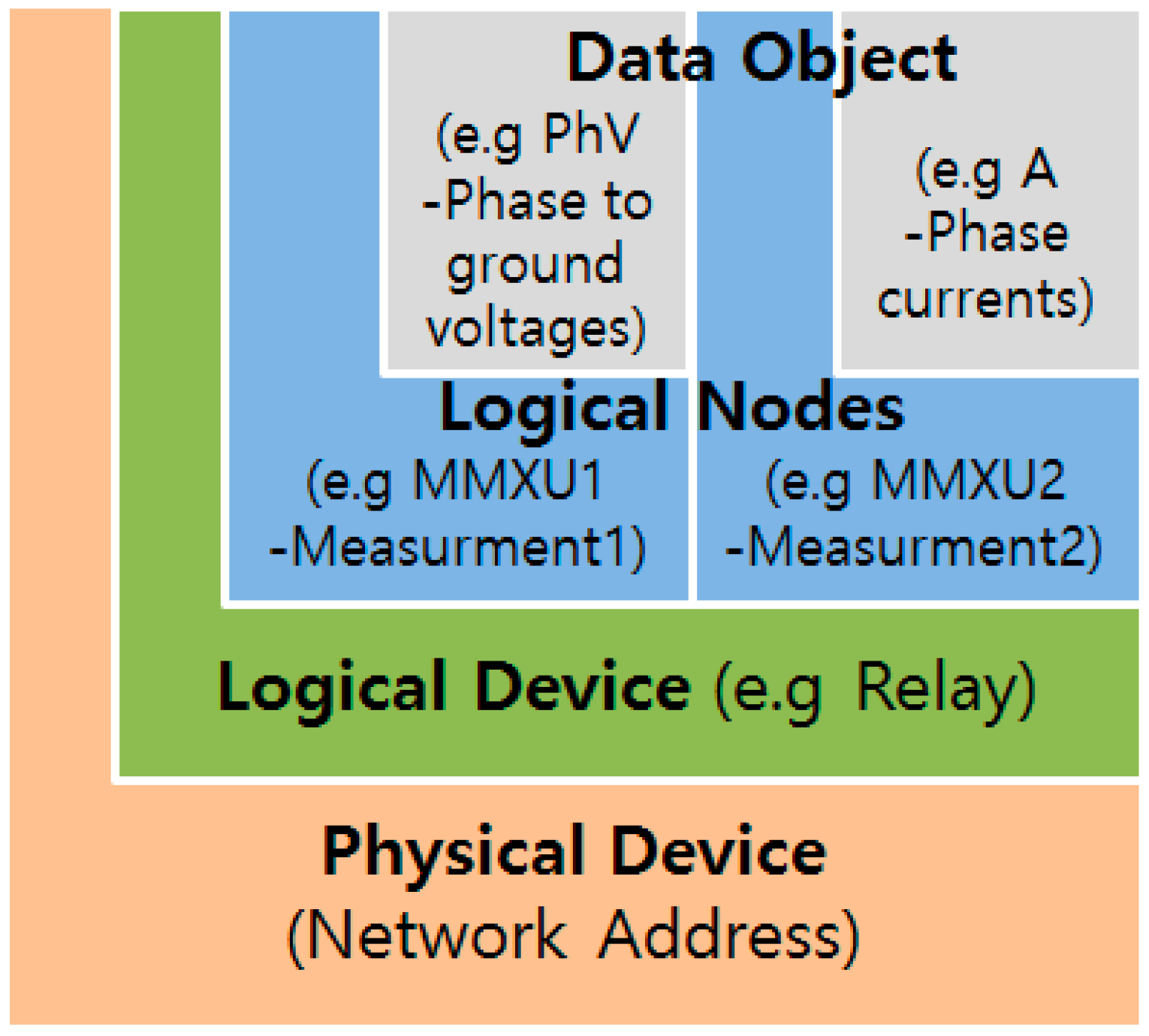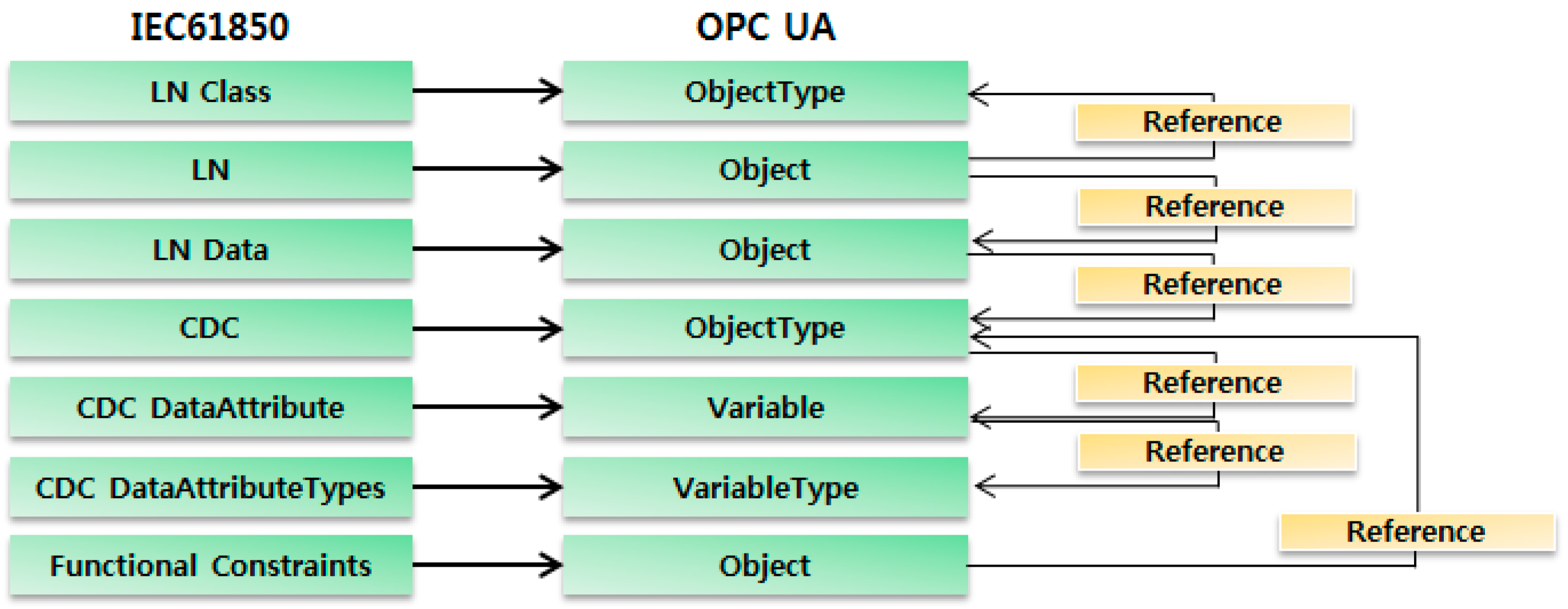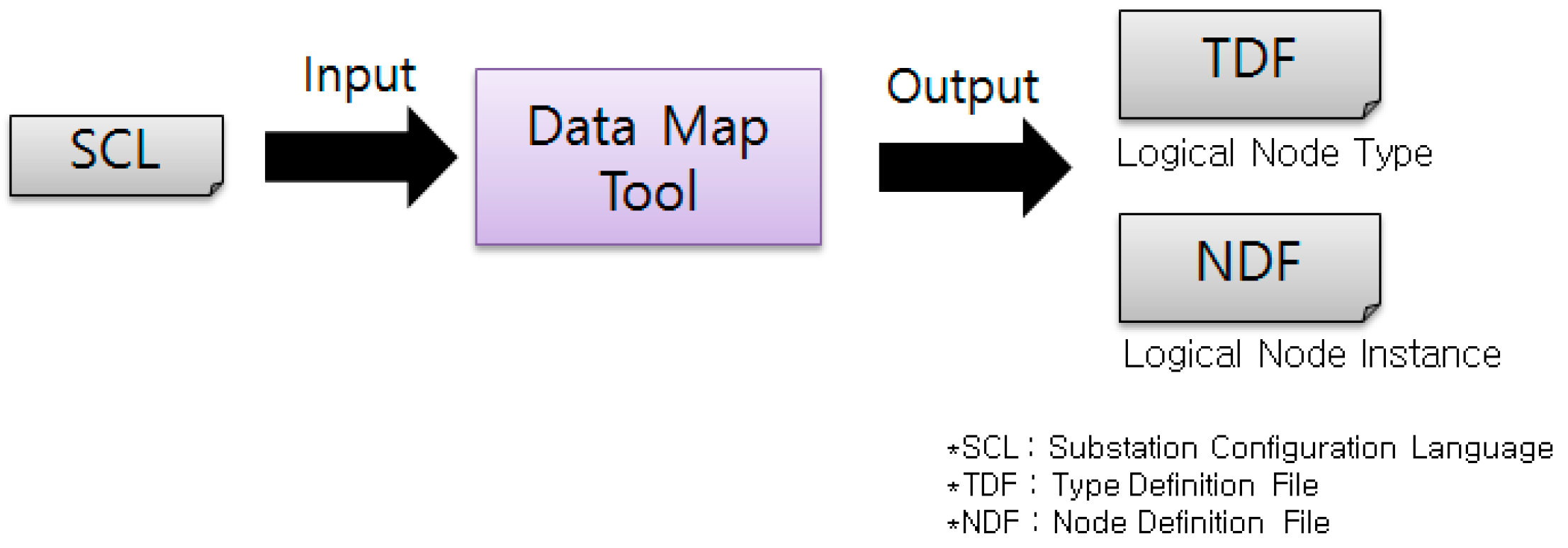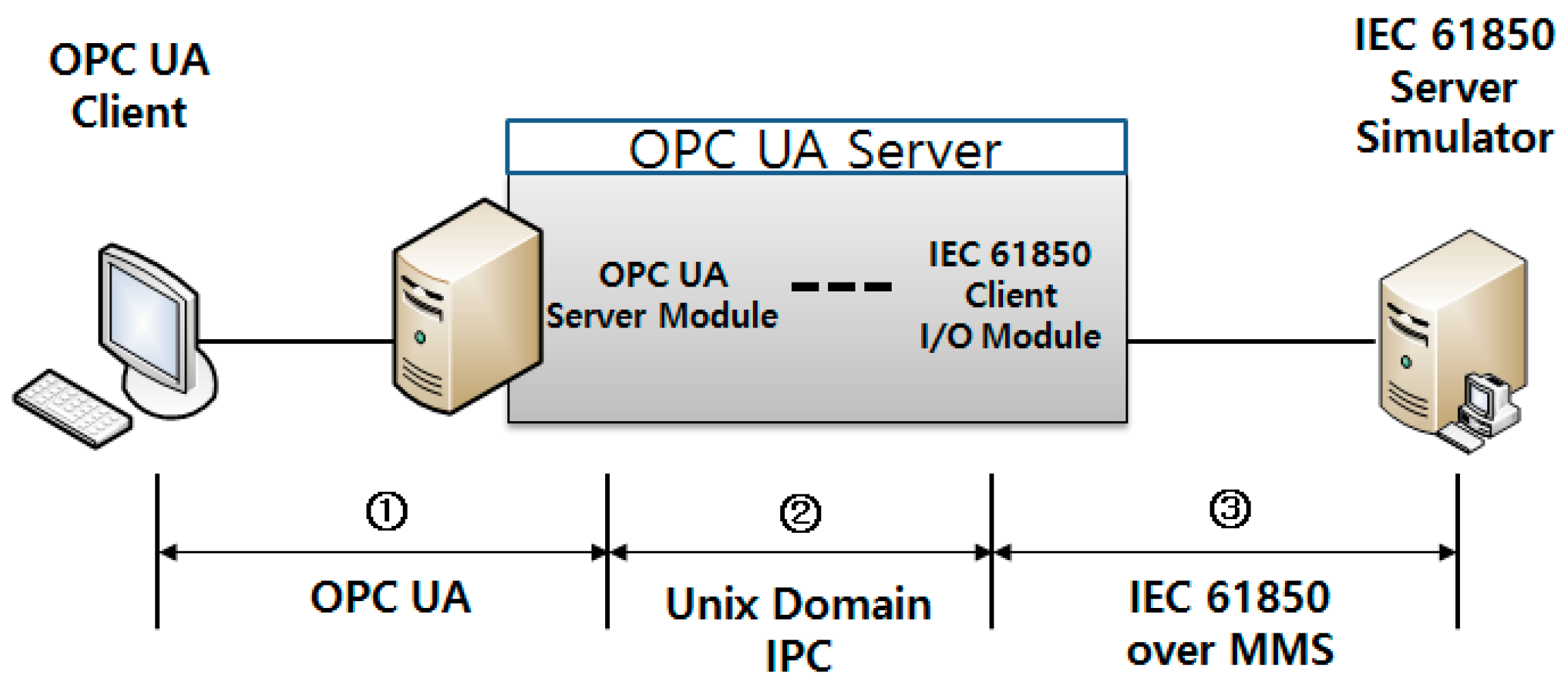Auto-Mapping and Configuration Method of IEC 61850 Information Model Based on OPC UA
Abstract
:1. Introduction
2. IEC 61850 Model Mapping onto OPC UA
2.1. OPC UA (IEC62451) Standard
2.2. IEC 61850 Standard
- The definition of the basic model of the utility information models contained in IEC 61850-7-3 (common data classes for utility automation applications), IEC 61850-7-4 (compatible logical node classes and compatible data classes for utility automation applications), and IEC 61850-6 (the substation configuration language).
- The definition of information exchange service models.
2.3. Design of OPC UA AddressSpace for IEC 61850
- -
- HasComponent describes part of the relationship between LN and its attributes as well as between CDC and its attributes. Furthermore, it is used for the grouping by FC.
- -
- Organizes is used to group the CDC attributes by FC.
- -
- HasTypeDefinition connects the LN attributes with the according CDC.
2.4. SCL to OPC UA AddressSpace Module Implementation
3. Experimental Results and Performance Evaluation
4. Conclusions
Acknowledgments
Author Contributions
Conflicts of Interest
References
- Lehnhoff, S.; Rohjans, S.; Uslar, M.; Mahnke, W. OPC UA Unified Architecture: A Service-Oriented Architecture for Smart Grids. In Proceedings of the First International Workshop on Software Engineering Challenges for the Smart Grid, Zurich, Switzerland, 2–9 June 2012.
- Lehnhoff, S.; Mahnke, W.; Rohjans, S.; Uslar, M. IEC 61850 based OPC UA Communication—The Future of Smart Grid Automation. In Proceedings of the 17th Power Systems Computation Conference (PSCC’11), Stockholm, Sweden, 22–26 August 2011.
- International Electrotechnical Commission. Part 1: Overview and Concepts. In IEC 62541-1: OPC Unified Architecture, 1st ed.; Springer: Berlin/Heidelberg, Germany, 2008. [Google Scholar]
- Naumann, A.; Bielchev, I.; Voropai, N.; Styczynski, Z. Smart grid automation using IEC 61850 and CIM standards. Control Eng. Pract. 2014, 25, 102–111. [Google Scholar] [CrossRef]
- Buchholz, B.M.; Brunner, C.; Naumann, A.; Styczynski, Z. Applying IEC standards for communication and data management as the backbone of smart distribution. In Proceedings of the 2012 IEEE Power and Energy Society General Meeting (PES 2012), San Diego, CA, USA, 22–26 July 2012.
- Cavalieri, S.; Regalbuto, A. Integration of IEC 61850 SCL and OPC UA to improve interoperability in Smart Grid environment. Comput. Stand. Interfaces 2016, 47, 77–99. [Google Scholar] [CrossRef]
- Srinivasan, S.; Kumar, R.; Vain, J. Integration of IEC 61850 and OPC UA for Smart Grid automation. In Proceedings of the 2013 IEEE Innovative Smart Grid Technologies-Asia (ISGT Asia), Bangalore, India, 10–13 November 2013.
- Cintuglu, M.H.; Martin, H.; Mohammed, O.A. An intelligent multi agent framework for active distribution networks based on IEC 61850 and FIPA standards. In Proceedings of the 2015 18th International Conference on Intelligent System Application to Power Systems (ISAP), Porto, Portugal, 11–16 September 2015.
- Mahnke, W.; Leitner, S.-H.; Damm, M. OPC Unified Architecture; Springer: Berlin/Heidelberg, Germany, 2009. [Google Scholar]
- International Electrotechnical Commission. Part 3: Address Space Model. In IEC 62541-3: OPC Unified Architecture, 1st ed.; Springer: Berlin/Heidelberg, Germany, 2008. [Google Scholar]
- International Electrotechnical Commission. Part 7-1: Basic Communication Structure—Principles and Models. In International Standard IEC 61850, Communication Networks and Systems for Power Utility Automation, 2nd ed.; IEC: Geneva, Switzerland, 2010. [Google Scholar]
- International Electrotechnical Commission. Part 7-2: Basic Information and Communication Structure Abstract Communication Service Interface (ACSI). In International Standard IEC 61850, Communication Networks and SYSTEMS for Power Utility Automation, 2nd ed.; IEC: Geneva, Switzerland, 2010. [Google Scholar]
- International Electrotechnical Commission. Part 7-3: Basic Communication Structure for Substation and Feeder Equipment Common Data Classes. In International Standard IEC 61850, Communication Networks and Systems for Power Utility Automation, 2nd ed.; IEC: Geneva, Switzerland, 2010. [Google Scholar]
- International Electrotechnical Commission. Part 8-1: Specific Communication Service Mapping (SCSM)—Mappings to MMS (ISO 9506-1 and ISO 9506-2) and to ISO/IEC 8802-3. In International Standard IEC 61850, Communication Networks and Systems for Power Utility Automation, 2nd ed.; IEC: Geneva, Switzerland, 2011. [Google Scholar]
- International Electrotechnical Commission. Part 6: Configuration Description Language for Communication in Electrical Substations. In International Standard IEC 61850, Communication Networks and Systems for Power Utility Automation, 2nd ed.; IEC: Geneva, Switzerland, 2009. [Google Scholar]
- International Electrotechnical Commission. Part 7-4: Basic communication structure—Compatible Logical Node Classes and Data Object Classes. In International Standard IEC 61850, Communication Networks and Systems for Power Utility Automation, 2nd ed.; IEC: Geneva, Switzerland, 2010. [Google Scholar]
- Unified Automation, UA Server SDK C++ Bundle 1.3.1. Available online: www.unified-automation.com (accessed on 24 June 2016).
- SISCO Inc. MMS-EASE Lite 5.02; SISCO Inc.: Rancho Dominguez, CA, USA, 2008. [Google Scholar]
- DNV KEMA Energy & Sustainability, UniCA IED Simulator User Manual; DNV KEMA: Groningen, The Netherlands, 2012.
- Unified Automation, UA Modeler. Available online: www.unified-automation.com (accessed on 24 June 2016).


















| Logical Node Groups | Number of Logical Nodes |
|---|---|
| System logical nodes | 3 |
| Protection functions | 28 |
| Protection related functions | 10 |
| Supervisory control | 5 |
| Generic references | 3 |
| Interfacing and archiving | 4 |
| Automatic control | 4 |
| Metering and measurement | 8 |
| Sensors and monitoring | 4 |
| Switchgear | 2 |
| Instrument transformer | 2 |
| Power transformer | 4 |
| Further power system equipment | 15 |
| Total number of logical nodes | 92 |
| IEC 61850 BasicTypes | OPC UA BaseDataType |
|---|---|
| BOOLEAN | Boolean |
| INT8 | Number-Integer-Sbyte |
| INT16 | Number-Integer-Int16 |
| INT24 | Number-Integer-Int32 |
| INT32 | Number-Integer-Int32 |
| INT128 | Number-Integer-Int64 |
| INT8U | Number-Integer-Uinteger-Byte |
| INT16U | Number-Integer-Uinteger-UInt16 |
| INT24U | Number-Integer-Uinteger-UInt32 |
| INT32U | Number-Integer-Uinteger-UInt32 |
| FLOAT32 | Number-Float |
| FLOAT64 | Number-Double |
| ENUMERATED | Enumeration |
| CODED ENUM | Enumeration |
| OCTET STRING | ByteString |
| VISIBLE STRING | String |
| UNICODE STRING | String |
| PDS Type | |||
|---|---|---|---|
| Name | Type Definition | Data Type | Node Class Type |
| Data Name | |||
| Data Attribute | |||
| Status | |||
| stVal | Enum_stVal | Enumeration | Variable |
| q | Quality_type | BaseDataType | Variable |
| t | TimeStamp_type | BaseDataType | Variable |
| Substitution | |||
| subEna | DataAttribute_Type | Boolean | Variable |
| subVal | Dnum_stVal | Enumeration | Variable |
| subQ | Quality_type | BaseDataType | Variable |
| subID | DataAttribute_Type | String | Variable |
| Configuration, description and extension | |||
| d | DataAttribute_Type | String | Variable |
| dU | DataAttribute_Type | String | Variable |
| cdcNs | DataAttribute_Type | String | Variable |
| cdcName | DataAttribute_Type | String | Variable |
| dataNs | DataAttribute_Type | String | Variable |
| XCBR Type | ||||
|---|---|---|---|---|
| Name | Type Definition | Modeling Rule | Data Type | Node Class |
| LLName | ObjectName_Type | Mandatory | BaseDataType | Variable |
| Data | ||||
| Data from Common_LN_Type | Override Instance Declaration | Mandatory | Object | |
| Loc | SPS_Type | Mandatory | Object | |
| EEHealth | INS_Type | Optional | Object | |
| EEName | DPL_Type | Optional | Object | |
| OpCnt | INS_Type | Mandatory | Object | |
| Pos | DPC_Type | Mandatory | Object | |
| BlkOpn | SPC_Type | Mandatory | Object | |
| BlkCls | SPC_Type | Mandatory | Object | |
| ChamotEna | SPC_Type | Optional | Object | |
| SumSwARs | BCR_Type | Optional | Object | |
| CBOpCap | INS_Type | Mandatory | Object | |
| POWCap | INS_Type | Optional | Object | |
| MaxOpCap | INS_Type | Optional | Object | |
| Component | OPC UA Client | OPC UA Server | IEC 61850 Client | IEC 61850 Server |
|---|---|---|---|---|
| OS | Ubuntu 14.04 | Ubuntu 14.04 | Ubuntu 14.04 | Windows |
| Tool | UA’s UaExpert | KEMA’s UniCA IED Simulator | ||
| SDK | UA’s OPC UA SDK 1.3.1 | Sisco’s MMS-EASE Lite 5.02 | ||
| Language | C++ | C |
| Metric | IED A | IED B | IED C | IED D |
|---|---|---|---|---|
| Logical Device(Num) | 2 | 4 | 1 | 4 |
| Logical Node(Num) | 80 | 217 | 81 | 116 |
| Data Object(Num) | 979 | 2532 | 840 | 809 |
| Data Attribute(Num) | 2795 | 6276 | 2095 | 2108 |
| Conversion (%) | 100% | 100% | 100% | 100% |
© 2016 by the authors; licensee MDPI, Basel, Switzerland. This article is an open access article distributed under the terms and conditions of the Creative Commons Attribution (CC-BY) license (http://creativecommons.org/licenses/by/4.0/).
Share and Cite
Shin, I.-J.; Song, B.-K.; Eom, D.-S. Auto-Mapping and Configuration Method of IEC 61850 Information Model Based on OPC UA. Energies 2016, 9, 901. https://doi.org/10.3390/en9110901
Shin I-J, Song B-K, Eom D-S. Auto-Mapping and Configuration Method of IEC 61850 Information Model Based on OPC UA. Energies. 2016; 9(11):901. https://doi.org/10.3390/en9110901
Chicago/Turabian StyleShin, In-Jae, Byung-Kwen Song, and Doo-Seop Eom. 2016. "Auto-Mapping and Configuration Method of IEC 61850 Information Model Based on OPC UA" Energies 9, no. 11: 901. https://doi.org/10.3390/en9110901
APA StyleShin, I. -J., Song, B. -K., & Eom, D. -S. (2016). Auto-Mapping and Configuration Method of IEC 61850 Information Model Based on OPC UA. Energies, 9(11), 901. https://doi.org/10.3390/en9110901





